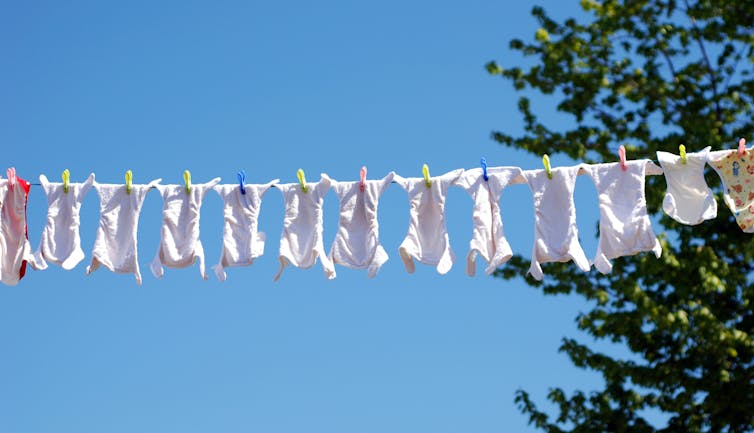New Africa/Shutterstock
Sharon George, Keele University
Around the world, another 45 babies are born every ten seconds. Each of these babies will require nappies that need to be changed frequently. So it’s understandable that new parents want to do what’s best for their baby – and the planet – when it comes to the all-important nappy change.
With the advent of disposable nappies, the experience of wrestling children into rubbery triangles of cloth while attempting to pin everything in place has become a thing of the past. These single-use nappies are more absorbent and are designed for quick and easy changing.
Disposable nappies have transformed the lives of busy parents. But this popular option has its drawbacks. Disposable nappies are difficult to recycle. Many end up being dumped in the environment or sent to landfill. One study found that more than 300,000 disposable nappies are incinerated, sent to landfill or end up in the environment every minute.
These nappies also contain several different plastics which take years to break down, and when they do they release harmful microplastics. The waste – and chemicals – inside the nappy itself can also end up leaching out into the environment and contaminating soil and water sources.
However, there are potentially more sustainable alternatives. One is biodegradable nappies. But even these nappies have been met with criticism – all biodegradable nappies contain some plastic materials (like sticky tabs made from polyurethane) so will take many years to break down.
Increasing uptake of reusable nappies is another option. It would certainly generate less plastic waste, but whether reusable nappies are truly a better environmental choice is unclear.
Environmental footprint of nappies
In 2008, the Environment Agency carried out a study comparing the lifecycle environmental footprint of different nappy options in the UK. This study found little difference between the environmental impact of disposable and reusable nappies.
This study has been recently updated. The new report analysed the carbon footprint of reusable and disposable nappies in greater detail and considered how things have changed 15 years on.
Both options are now more sustainable. We have more renewable energy in our energy mix, so the production, packaging and transportation of nappies is now more efficient. Disposable nappies are also lighter and more compact than they were before, so require less packaging and energy to transport.
The environmental impact of both reusable and disposable nappies is, however, still relatively large. The carbon footprint of using disposable nappies for one child up to the age of two and a half is now the equivalent of 457 kg of CO₂ (although this is 27% less than in 2008). Reusable nappies (which this time considered more reusable nappy options than the original study) had 25% less global heating potential – but their carbon footprint was still the equivalent of 345 kg of CO₂.
Disposables performed worse on six environmental impact categories. This was mostly down to how the nappy was produced and disposed of.
Due to the use of plastics, disposable nappies were associated with 40% more fossil fuel use than reusables. The environmental impact of single-use nappies was also much higher when it came to disposal. These nappies had a 26% higher impact on freshwater eutrophication (where water is overloaded with nutrients).
So, does this mean that new parents should rush out and buy reusable nappies? Maybe, but with a note of caution. Reusable nappies were outperformed by disposables on 11 of the 18 environmental factors considered.
This was associated mainly with the electricity and detergent used to wash and dry them. The latter caused 333% more marine pollution than the use of disposable nappies.
Reducing your footprint
The good news is that this impact is something that we can control. Parents can lower their impact by washing nappies at lower temperature settings or in more efficient machines, avoiding the tumble drier and extending their use by passing them on to other children.
Another option is washing nappies together in full washing loads. But this would require having sufficient nappies available to allow storage of used nappies while also having a clean and dry supply for your baby.
One way of making sure the laundry is done efficiently is to sign up to a local nappy laundry service if there is one nearby. These companies collect your dirty nappies and give you freshly-laundered ones in return.
Whichever type of nappy we use, a final thing we could do is to toilet train our children earlier. The updated study revealed that, since 2008, parents have shifted to potty training their children at a later stage in their development. Around 37% of children aged two and a half, for example, are still wearing disposable nappies, while 35% were still in reusable nappies – 19.4% and 17.4% more than in 2008 respectively. This means that we are producing, using and transporting more nappies, and using more water and energy to wash them.

Robin Phinizy/Shutterstock
Reusable nappies can help to lower our carbon footprint. But only if we wash at lower temperatures, with efficient equipment and avoid tumble drying. In the UK, especially in winter, this last point could be an issue, so having a mixed approach would be a suitable compromise.
Parents could continue to choose disposable nappies when line drying is difficult. There are also several steps we can take to lessen the environmental impact of disposable nappies are their use. Not dumping them in the environment is a good start – but making sure they go to a waste-to-energy incinerator, or even better, there are now ways to recycle them and turn them into something new.![]()
Sharon George, Research Chair, Indigenous Approaches to Environmental Management, Keele University
This article is republished from The Conversation under a Creative Commons license. Read the original article.


Recent Comments